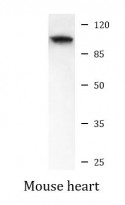ARG53983
anti-UHRF1 antibody (N-term)
anti-UHRF1 antibody (N-term) for Western blot and Human,Mouse
Gene Regulation antibody
Overview
| Product Description | Mouse Monoclonal antibody recognizes UHRF1 |
|---|---|
| Tested Reactivity | Hu, Ms |
| Tested Application | WB |
| Host | Mouse |
| Clonality | Monoclonal |
| Isotype | IgG2b |
| Target Name | UHRF1 |
| Antigen Species | Human |
| Immunogen | Purified recombinant human UHRF1 protein fragments expressed in E.coil. |
| Conjugation | Un-conjugated |
| Alternate Names | Nuclear zinc finger protein Np95; HuNp95; EC 6.3.2.-; hUHRF1; RING finger protein 106; hNp95; Ubiquitin-like PHD and RING finger domain-containing protein 1; Nuclear protein 95; ICBP90; Transcription factor ICBP90; RNF106; Np95; Inverted CCAAT box-binding protein of 90 kDa; Ubiquitin-like-containing PHD and RING finger domains protein 1; huNp95; E3 ubiquitin-protein ligase UHRF1; hNP95 |
Application Instructions
| Application Suggestion |
|
||||
|---|---|---|---|---|---|
| Application Note | * The dilutions indicate recommended starting dilutions and the optimal dilutions or concentrations should be determined by the scientist. | ||||
| Observed Size | 90 kDa |
Properties
| Form | Liquid |
|---|---|
| Purification | Affinity purified |
| Buffer | 0.1M Tris-Glycine (pH 7.4), 150 mM NaCl, 0.2% Sodium azide and 50% Glycerol |
| Preservative | 0.2% Sodium azide |
| Stabilizer | 50% Glycerol |
| Concentration | 1 mg/ml |
| Storage Instruction | For continuous use, store undiluted antibody at 2-8°C for up to a week. For long-term storage, aliquot and store at -20°C. Storage in frost free freezers is not recommended. Avoid repeated freeze/thaw cycles. Suggest spin the vial prior to opening. The antibody solution should be gently mixed before use. |
| Note | For laboratory research only, not for drug, diagnostic or other use. |
Bioinformation
| Database Links | |
|---|---|
| Gene Symbol | UHRF1 |
| Gene Full Name | ubiquitin-like with PHD and ring finger domains 1 |
| Background | Putative E3 ubiquitin-protein ligase. May participate in methylation-dependent transcriptional regulation. Binds to inverted 5'-CCAAT-3' box 2 in the TOP2A promoter, and activates TOP2A expression. Important for G1/S transition. May be involved in DNA repair and chromosomal stability. |
| Function | Multidomain protein that acts as a key epigenetic regulator by bridging DNA methylation and chromatin modification. Specifically recognizes and binds hemimethylated DNA at replication forks via its YDG domain and recruits DNMT1 methyltransferase to ensure faithful propagation of the DNA methylation patterns through DNA replication. In addition to its role in maintenance of DNA methylation, also plays a key role in chromatin modification: through its tudor-like regions and PHD-type zinc fingers, specifically recognizes and binds histone H3 trimethylated at 'Lys-9' (H3K9me3) and unmethylated at 'Arg-2' (H3R2me0), respectively, and recruits chromatin proteins. Enriched in pericentric heterochromatin where it recruits different chromatin modifiers required for this chromatin replication. Also localizes to euchromatic regions where it negatively regulates transcription possibly by impacting DNA methylation and histone modifications. Has E3 ubiquitin-protein ligase activity by mediating the ubiquitination of target proteins such as histone H3 and PML. It is still unclear how E3 ubiquitin-protein ligase activity is related to its role in chromatin in vivo. May be involved in DNA repair. [UniProt] |
| Cellular Localization | Nucleus |
| Research Area | Gene Regulation antibody |
| Calculated MW | 90 kDa |
| PTM | Phosphorylation at Ser-298 of the linker region decreases the binding to H3K9me3. Phosphorylation at Ser-639 by CDK1 during M phase impairs interaction with USP7, preventing deubiquitination and leading to degradation by the proteasome. Ubiquitinated; which leads to proteasomal degradation. Autoubiquitinated; interaction with USP7 leads to deubiquitination and prevents degradation. Ubiquitination and degradation takes place during M phase, when phosphorylation at Ser-639 prevents intereaction with USP7 and subsequent deubiquitination. Polyubiquitination may be stimulated by DNA damage. |
Images (1) Click the Picture to Zoom In






